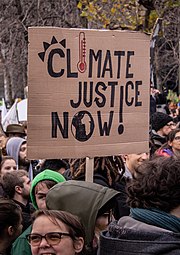BaCCC/Module 3/Lesson 3/Part 1
Contents
Module 3, Lesson 3, Part 1: Addressing Climate Injustice
Introduction
In this short introduction to climate justice, it has been hard to cover over 500 years of colonisation and oppression. But we have defined climate justice and looked at examples of climate injustice. It has become clear that climate change disproportionately impacts marginalised communities, including people of colour, low-income populations, Indigenous communities and women and children. This lesson is dedicated to discovering ways in which we can ensure fairness, equity and inclusiveness in our fight to reduce greenhouse gas emissions, protect natural resources, and safeguard a safe and habitable world for all.
Climate justice is a reshaping of climate action from a technical effort to cut emissions into an approach that also addresses human rights and social inequality. As industrialised nations and corporations have amassed wealth by burning fossil fuels, many also argue that a “just” outcome would involve them redistributing more of this wealth towards those having to deal with the consequences. (Gabatiss & Tandon, 2021)
Terminology
The following terms are important in understanding the science behind climate change. If you want to remember them, write their meanings in your learning journal as you encounter them in the course content.
- adaptation
- high emitters
- mitigation
- transfer
Who is responsible for addressing climate injustice? And who is not?
| “ | The injustice of the whole issue of global warming and climate change lies in the fact that those who have contributed nothing to its genesis will suffer the most from its consequences. | ” |
| —Meles Zenawi, former Prime Minister of Ethiopia | ||
It has probably become quite clear to you which countries are responsible for righting the wrongs of climate injustice, and which are not:
- A key element of climate justice is for high emitters to rapidly reduce our own emissions. By doing so, we leave more space for people who need their emissions to survive, and we lessen their burden in facing increasing impacts of climate change they haven’t caused. — Professor Kimberly Nicholas, sustainability scientist and writer, Sweden
- The people of the Global South deserve the same quality of life as the people in the Global North, but this remains unachievable for them unless there is a transfer of knowledge, technology and wealth. — Dr Kaveh Madani, Iranian scientist and activist
- We call for justice because the current crisis is no longer fuelled by ignorance but by wilful greed. — Adrián Martinez, Director, La Ruta del Clima
- In global terms, [climate justice] means that wealthy countries like the US must lead by example when it comes to climate action. — Brandon Wu, Director of Policy and Campaigns for ActionAid USA
To recap:
- “High emitters” must reduce their emissions.
- This is to “leave space” so that un(der)developed countries can still use some of their fair share of fossil fuel energy for mitigation and adaptation strategies (and, we hope, the transition to a virtually zero-carbon energy economy).
- Without a transfer from the Global North to the Global South of “knowledge, technology and wealth” (which was pledged in the 1992 UNFCCC agreement), this remains unachievable.
- The injustice to those “facing increasing impacts of climate change they haven’t caused” is now being caused by “wilful greed” on the part of wealthy nations and individuals, not just ignorance. Repeat: The climate crisis is no longer happening because we do not know better but due to deliberate, intentional, premeditated greed. This is the worst kind of injustice.
- Wealthy countries need to step up, reduce their own emissions and help other countries at the same time.
(You can adjust the playback speed and/or turn on subtitles/captions.)
If you have trouble accessing the video, a summary is available below.
H5P Object Parameters
The H5P parameters below will be replaced by the actual H5P object when it's rendered on the WordPress site to which it's been snapshotted.
Historical responsibility for climate change is at the heart of debates over climate justice. History matters because the cumulative amount of carbon dioxide emitted since the start of the Industrial Revolution is closely tied to the 1.2ºC of warming that has already occurred. (Evans, 2021)
More information can be found here:
Which Countries Are Historically Responsible for Climate Change?[1]
We know clearly who is responsible for climate injustice. But who is responsible for responding to it, maybe even resolving it?
In the next Part, we will look at each one in turn.
References
- ↑ Science Direct, n.d. Which Countries Are Historically Responsible for Climate Change?


